|
When I first saw the Talon Zephyr I thought it
was a 1/2A model because of the familiar engine shape. It turns out to be a Tee Dee Cox .15. Although
Cox ceased making the engines long ago, you can still occasionally find one listed on
eBay. In fact, I just looked and there's one available for $105. That's a lot more
than the typical 1970s era price of about $20, but compared to a new high quality engine today, the
price is not out of line. The biggest issue is keeping a supply of the glow heads available. Some people
have successfully drilled and tapped the center area to accept a standard threaded glow plug. But I
digress. The Talon Zephyr might be a great model to scale down to .049 size and some modern miniature
R/C equipment.
Talon Zephyr
By Weldon Smith and Bob Baldwin
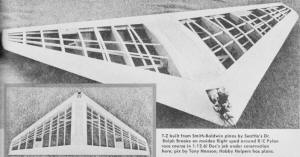 A super-hot hopped-up Max 15 has been sent along to us by
Walt Schroder, so maybe we'll have an even faster pylon delta racer next season. 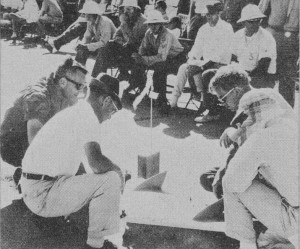
During Nats the race pilots gather
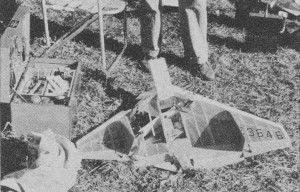
Remains of crash "heard 'round the modeling world" below. Everybody
amazed by T-Z's speed.
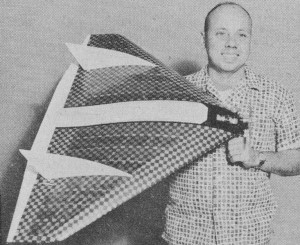
Dr. Brooke (below) and his T-Z; seen bottom of page without
receiver. Doc reports he uses no switches, just plugs in power pack.
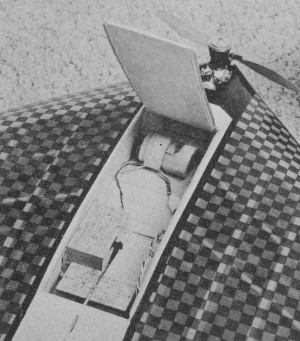
Radio compartment.
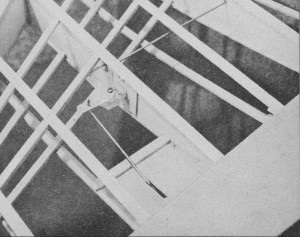
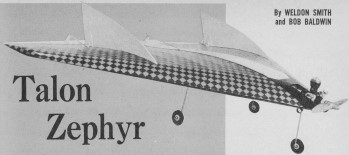
Witnesses to "Talon
Zephyr" flights at the '62 Nats all agreed that it was the fastest ship entered in the Pylon event.
The belief that the Delta configuration is best for speed was widely expressed. For the benefit of those
who have expressed a desire to build a .15-size ship, the plans are presented herewith. Should you have
no interest in pylon flying and want only a high performance aircraft, the Talon Zephyr will still meet
your needs. The craft will climb out of sight vertically since thrust can exceed weight.
Bob and I had built many Deltas before we began plans for our 1960 model. We had worked together
in his basement for many an evening incorporating the best features our previous ships into the design.
Bob began construction immediately, but prior to completion of mine, I had heard of the new Tee Dee
.15 and decided that this one would be built around that engine. Some delay ensued while I laid out
plans for the little ship, but construction proved simple, and my craft was ready to fly before the
"Hustler" was completed. Having used Talon zippers, at Bob's suggestion, I called it the Talon Special."
The Special was destined to a short life.
On the first flight excessive up trim resulted in too much altitude too fast. A prolonged dive to
bring it back resulted in too much speed and the point at which vibration found the right aileron reed
was soon reached. Surprisingly, the ship was not damaged beyond repair, but since construction is simple,
I decided to build anew.
The phenomenal climb of Talon Special sparked a thought which was to be used in the new ship - VTO.
Considerable weight can be saved by eliminating the landing gear. Talon Special tipped the scales at
three pounds. I figured that without the gear, and with lighter equipment, the ship could be flown at
2 pounds even. The Special flew with three servos, one being used for elevator trim, but it was decided
to use only two in the Zephyr.
The receiver posed a problem until the Toledo R/C conference in February '62. While there, I saw
the New Haven Superhet 10 channel. Immediately on returning home I wrote Jack Fisher and explained my
problem, emphasizing the fact that I was concerned about vibration. He assured me that there would be
no troubles, so the receiver was ordered. The ship although completed shortly thereafter still had not
flown when we attended the Ft. Wayne meet in June. We explained to Jack that I was still waiting for
a transmitter to fly the ship. He offered to match his reed bank to my transmitter, and weighted the
reeds that night. Again the vibration bugaboo worried me, but since Jack was willing to risk the reputation
of his reed bank by increasing the weight of the reeds, I was willing to risk a ship which could be
replaced in two weeks. My fears proved to be unfounded, and the two ounce receiver contributed greatly
to keeping the weight at two pounds ready to fly.
T-Z built from Smith-Baldwin plans by Seattle's Dr. Ralph Brooke on maiden flight sped around R/C
Pylon race course in 1:12.6! Doc's job under construction here; pix by Tony Hanson; Hobby Helpers has
plans.
Hand launching for test flights proved no great problem. Static thrust of the Tee Dee exceeded weight
of the little craft - shown by the fact that we could hold it down vertically with open palms over its
leading edges while the little mill screamed. On the first flight, Bob just held it near the wing tips
and gave it a flip when I nodded.
A VTO was scheduled on the second flight. On release, it rolled to the left and streaked under the
rope fence about one hundred feet away. It was half way through the parking lot before I regained my
composure and began flying it.
Since time was catching up with us a landing gear was added that night. Test flights continued and
the ship was trimmed out, but no time was available for practice on the pylon course before the Nats.
Tank problems aborted the first three attempts at the Nationals. These were corrected between the third
and fourth rounds and the ship performed as intended on the fourth try. Because of an error, only four
laps were completed on this round. On the next attempt, the near pylon somehow got in the way; the steel
post sliced the ship in half, so no official times were posted. However, it appears that a time of one
minute flat is possible if an experienced pilot is flying the course.
Building poses no particular problems if done in a jig which supports the leading and trailing edges
above the table. Though the ship gets its name from nylon zippers, it is recommended that metal zippers
be used. The nylon tends to bind when side movement is restrained as in this application. Details of
construction on plan should require no explanation. Light weight balsa is essential to speed. For maximum
performance, weight should not exceed 2 1/2-lbs. The original, after modification to include landing
gear, weighed 39-oz. This gear, as explained, was an afterthought; it could be improved if built into
the ship.
Notice:
The AMA Plans Service offers a
full-size version of many of the plans show here at a very reasonable cost. They
will scale the plans any size for you. It is always best to buy printed plans because
my scanner versions often have distortions that can cause parts to fit poorly. Purchasing
plans also help to support the operation of the
Academy of Model Aeronautics - the #1
advocate for model aviation throughout the world. If the AMA no longer has this
plan on file, I will be glad to send you my higher resolution version.
Try my Scale Calculator for
Model Airplane Plans.
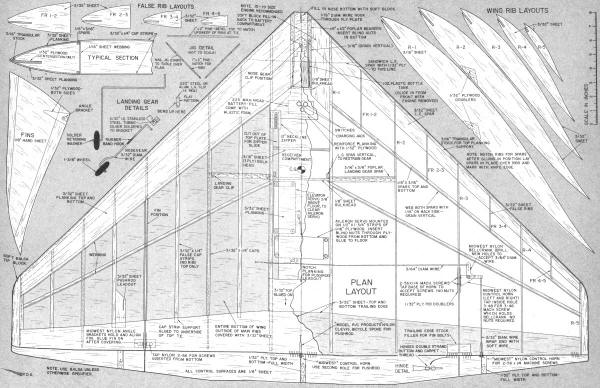 Talon Zephyr Plans
Talon Zephyr Plans
<click for larger version>
This scan is very skewed. AMA still sells these plans for $14
Notice:
The AMA Plans Service offers a
full-size version of many of the plans show here at a very reasonable cost. They
will scale the plans any size for you. It is always best to buy printed plans because
my scanner versions often have distortions that can cause parts to fit poorly. Purchasing
plans also help to support the operation of the
Academy of Model Aeronautics - the #1
advocate for model aviation throughout the world. If the AMA no longer has this
plan on file, I will be glad to send you my higher resolution version.
Try my Scale Calculator for
Model Airplane Plans.
Posted August 25, 2012
|



